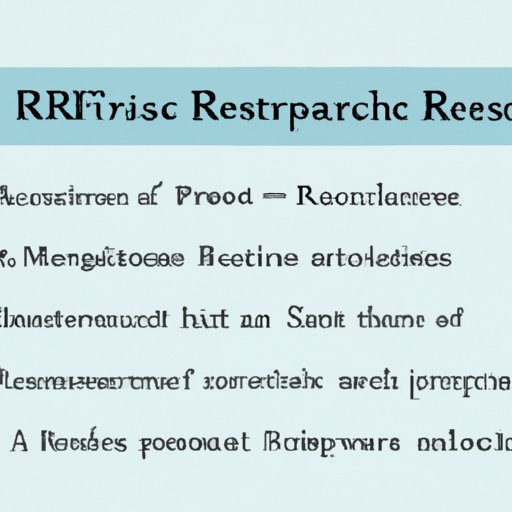
Introduction
If you’re a student or a professional researcher, you probably already know the importance of a well-written abstract for your research paper. An abstract is a concise summary of your research paper and serves as a brief overview of your work, summarizing key findings and conclusions.
The purpose of this article is to help you understand what an abstract is, what should be included, and how to write an effective one. With this step-by-step guide, you can craft a compelling abstract that accurately represents your research and attracts the interest of your audience.
Step-by-Step Guide
Before diving into the specifics of writing an abstract for a research paper, it’s important to understand what you’re trying to accomplish. An abstract should ideally include the purpose, methods, results, and conclusions of your research. Here are some steps to follow:
1. Identify the purpose of your research: Clearly define the purpose of your research, including the questions you wanted to answer or the problem you wanted to solve.
2. Describe your methodology: Briefly describe the methods you used to conduct your research, including any data collection techniques or analytical tools.
3. Summarize your key findings: Concisely summarize the key findings of your research, emphasizing their significance or importance.
4. State your conclusions: Clearly state the conclusions you reached based on your research and explain their implications or potential impact.
Common Mistakes to Avoid
There are several common mistakes people make when writing an abstract that can weaken their paper’s impact. Here are some tips on how to avoid them:
1. Including too much detail: The purpose of an abstract is to provide a brief summary of the key findings of your research, not to provide a detailed explanation of your methodology or analysis.
2. Not summarizing the key findings: You should aim to concisely summarize the main points of your research, with emphasis on the significant findings and conclusions.
3. Using excessive jargon: Avoid using technical terms or jargon that may be unfamiliar to your audience. Use clear and concise language to convey your findings.
Format Matters
The format and structure of your abstract can impact its effectiveness. Here are a few tips to keep in mind:
1. Follow the word count guidelines: Most research papers will have specific word count requirements for the abstract. Be sure to adhere to these guidelines.
2. Use section headings: Divide your abstract into sections, providing a clear and concise overview of each part of your research.
3. Use appropriate language and tone: Remember to use a professional tone and appropriate language when writing your abstract. Avoid informal or casual language.
Importance and Purpose
An abstract serves the important purpose of providing readers with an immediate understanding of the main points of a research paper. By quickly summarizing the key findings and conclusions, readers can determine whether a paper is relevant to their own research interests and decide whether to read the full article.
A well-written abstract can improve the chances of your research paper being read and cited. By crafting a compelling summary of your research, you can pique the interest of your audience and encourage them to engage with your work.
Best Practices
Here are some best practices to keep in mind when writing your abstract:
1. Use clear and concise language: The language you use in your abstract should be clear, concise, and easy to understand.
2. Focus on the key findings and conclusions: Your abstract should provide a concise summary of the most important findings and conclusions of your research.
3. Highlight the significance of your research: Emphasize the significance of your findings and their potential implications for future research.
Examples and Templates
Looking at examples of effective abstracts can be helpful when crafting your own. Here are a few resources that provide effective abstract templates you can use as a guide:
- Ohio State University Libraries: Example Abstracts
- University of Toronto: Types of Abstracts
- UNC Writing Center: Abstracts
Peer Review
Once you’ve drafted your abstract, it can be helpful to seek feedback from peers and colleagues. Getting an outside perspective can help you identify weaknesses and improve the quality of your abstract.
When incorporating feedback, be open to suggestions and willing to revise your abstract as needed. Be sure to carefully consider any critiques or suggestions and make changes accordingly.
Conclusion
Crafting an effective abstract is an important part of any research paper. By following these tips and strategies, you can create a concise and compelling summary of your research that accurately represents your findings and attracts readers.
Remember to keep your language clear and concise, focus on the key findings and conclusions of your research, and seek feedback from others to further improve the quality of your abstract.





